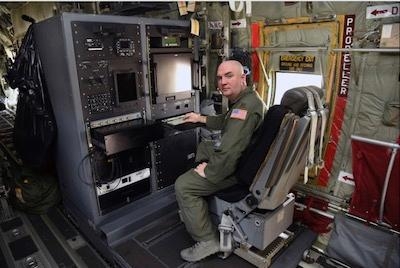Atlantic Hurricane Season Began June 1
The 53rd Weather Reconnaissance Squadron, aka Air Force Reserve “Hurricane Hunters,” based out of Keesler Air Force Base is the only Air Force unit tasked with the mission of collecting data from the inside of a storm and flying into the eye of hurricanes.

This specialized unit of Reserve Airmen is made up of a five-person crew consisting of a pilot, co-pilot, navigator, aerial reconnaissance weather officer and loadmaster who is also the dropsonde operator.
According to Maj. Kendall Dunn, 53rd WRS pilot, with the exception of the Hurricane Hunters, all aircraft are forbidden to fly into severe weather by the Federal Aviation Administration regulations. The Hurricane Hunters fly into storms to collect atmospheric data from within the storms which is provided to the National Hurricane Center for use in forecasts. “We fly into weather, when all other aircraft have to stay at least 20 miles out to avoid it,” Dunn said. “Flying into storms, this is our type of combat.”
Dunn has been flying with the Air Force Reserve since 2013, with approximately 1,500 flight hours in the WC-130J Super Hercules aircraft and has been into 25 named storms to date.
Every mission requires two pilots, one being the aircraft commander and the other is the co-pilot. The aircraft commander is responsible for all crewmembers, their safety and overall mission accomplishment. “Safety is the overall mission end state,” Dunn said. “The aircraft commander has the ultimate decision, but we do whatever we can to accomplish the mission and try to meet all National Hurricane Center requests.”
Adding to the safety of the weather mission are navigators, such as Capt. Julie Fantaske, 53rd WRS navigator, who has been a Reserve Airman for 16 years.
Fantaske, said that when the pilots are busy handling the airplane through severe weather, flying can become intense and navigators are there to assist when necessary. “Even though the navigator (position) has gone away in many other platforms, we’re an extra measure of safety,” Fantaske said. “We’re an extra set of eyes, and we are able to call things out and interject when needed, and it’s cool to be a part of such an important mission.”
Navigators are responsible for preparing flight plans, which include routes, headings, checkpoints and times. During flight, they operate from their station using equipment such as GPS, radio and radar systems that assists in guiding the aircraft through weather. “We all work closely together, because we have a limited window of time to get to a storm and collect data for the hurricane center’s forecasts,” Dunn said. “The weather officer is our go between for us and the hurricane center.”
The aerial reconnaissance weather officer acts like a flight director in a storm, by continuously monitoring atmospheric data collected from the aircraft’s sensors. This data is checked for accuracy and is used to guide the aircraft into the center of the storm.

“For most of us it’s really hard to fathom the responsibility you have,” said Maj. Tobi Baker, 53rd WRS ARWO (pictured). “You know you’re acting like a mission director on the plane and you’re actually inside of a storm as you’re collecting all this information. You’re technically the tip of the spear for the emergency management services. The stuff we start with here, ends up being in the products that possibly save millions of lives and assets.”
Baker said that being an ARWO is very rare career that not many get the chance to experience. “As an ARWO, this opportunity is unique, because you can say you’re one in 20 in the world that does your job. You get to experience something that Mother Nature produces, that not many others get to see with their naked eye,” said Baker. “There’s nothing like breaking through the eye-wall and have an open sky above you and being encompassed by a bowl of clouds around you that has so much destructive power.”
After penetrating into a storm, the ARWO directs when and where dropsonde sensors are released. Dropsondes are used to collect information such as temperature, pressure, wind direction and wind speed, from various locations inside of a storm and transmits those observations via satellite to the NHC.
The loadmaster, who doubles as a dropsonde operator launches the parachute-rigged device from the WC-130J using a dropsonde tube. “We’re loadmasters and our additional duty is dropping sondes,” said Master Sgt. Chris Becvar, 53rd WRS loadmaster, “We take care of the weight and balance of the airplane, meaning we make sure the cargo is loaded evenly so we can fly safely through the air.”
Becvar said that loadmasters receive a two-week in-house training to be a dropsonde systems operator, where they learn basic weather terminology, the computer station and tube operations. “Every storm is different so the number of dropsondes used varies,” Becvar said. “My favorite part of the job is getting different pieces of cargo and fitting it together like a puzzle, like ‘Tetris.’”
Although the crew members have different positions and responsibilities they all said the most rewarding part of the mission is the real-time mission impact.
“The (weather) mission and the level of responsibility we have to the public is a tall order that we take seriously,” Dunn said. “There is no other job that I would rather have.”
(Images provided with USAF news release)
 ANN's Daily Aero-Term (04.25.24): Airport Rotating Beacon
ANN's Daily Aero-Term (04.25.24): Airport Rotating Beacon ANN's Daily Aero-Linx (04.25.24)
ANN's Daily Aero-Linx (04.25.24) Klyde Morris (04.22.24)
Klyde Morris (04.22.24) Airborne 04.24.24: INTEGRAL E, Elixir USA, M700 RVSM
Airborne 04.24.24: INTEGRAL E, Elixir USA, M700 RVSM Airborne 04.22.24: Rotor X Worsens, Airport Fees 4 FNB?, USMC Drone Pilot
Airborne 04.22.24: Rotor X Worsens, Airport Fees 4 FNB?, USMC Drone Pilot




